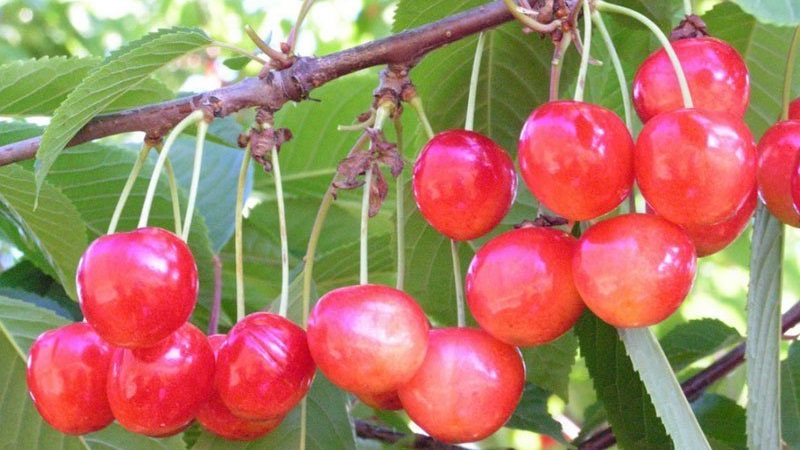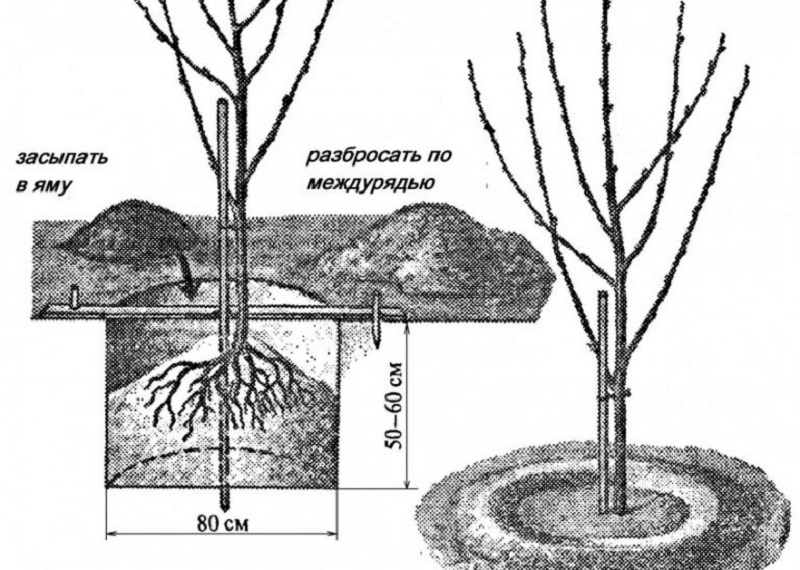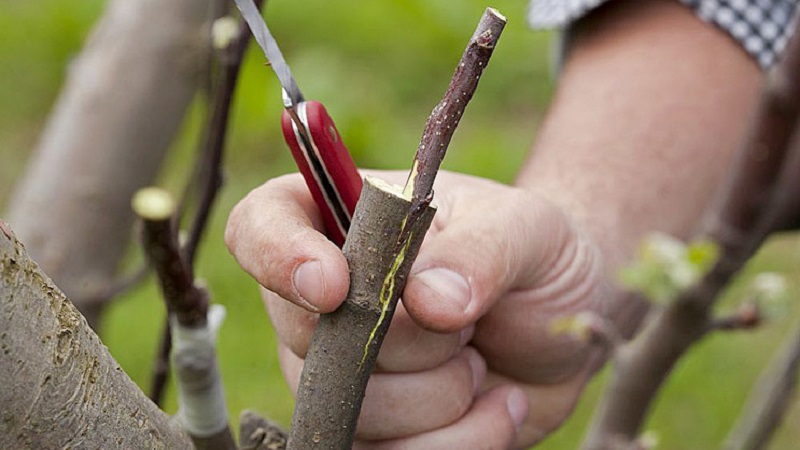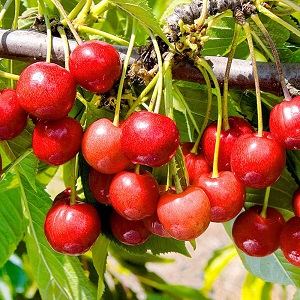The variety of early ripening cherries "Bryanskaya rozovaya", resistant to cold and diseases
Sweet cherry is the oldest variety of cherry, quite widespread not only in the southern regions, but also in central Russia. The Bryanskaya rozovaya variety was bred specifically for a temperate climate, but is also grown in more northern regions. It has won the trust of summer residents due to its cold resistance, stable harvest and easy maintenance.
The content of the article
What is this grade
Sweet cherry Bryansk pink will be a godsend for novice gardeners, will add variety to the personal plot.
History of origin and distribution
The variety was bred by breeders A. I. Astakhov and M. V. Kanshina in the Federal Research Center "VIK im. VR Williams "... Black Muscat cherry was taken as a starting material and seedlings with improved characteristics were developed. Official trials of the variety began in 1987, and already in 1993 the culture was entered into the State Register.
The plant spread over the middle lane in a short time and gained popularity among summer residents, gardeners and farms.

Trees characteristics
Bryanskaya pink is a self-fertile variety of late flowering and ripening... The trunk grows slowly, the maximum height of an adult tree is 3–3.6 m. The crown is pyramidal of medium density. Skeletal branches are located compactly at an acute angle relative to the trunk and slightly raised upward.
Shoots straight or slightly curved with a smooth gray-brown bark... In the active phase of the growing season, the buds take the form of an elongated egg, and in the generative phase they become oval. The leaves are large dark green, serrated at the edges and a pointed tip.
Inflorescences consist of 3 small flowers with a saucer-shaped rim. Long pistils and stamens are hidden in a glass-shaped cup. The buds grow on thick stalks.
Flowering begins in the second half of May.... At this time, the threat of recurrent frosts is minimal and nothing threatens the formation of ovaries.
Resistant to temperatures
Bryansk pink is characterized by increased frost resistance and winter hardiness, since it is zoned specifically for a temperate climate with a short summer. Grown in most horticultural regions without restrictions.
Attention! Spring frosts are dangerous when flower buds freeze and are damaged.
Moisture and drought resistance
The variety does not tolerate stagnant moisture at the roots, since the risk of illness or damping is high. It tolerates short dry weather well. Water is required during flowering and ovary formation, as well as in pre-winter preparation.
Disease and pest resistance
The plant is affected by pests of stone fruit crops and requires timely protection.
Bryanskaya rozova has a high tolerance to most common infectious diseases:
- coccomycosis;
- moniliosis;
- clotterosporia;
- fruit rot.
Minimal preventive treatment against pathogens and pests forms the basis of tree care.
Description of berries
 The first harvest is harvested only at the 5th year of the cherry's life, at the end of July. The berries are round, 2-3 cm in diameter, weighing 4-5 g. Ripe fruits are picked 3-5 days after ripening, otherwise they will start to deteriorate.For sale, the berries are harvested with stalks and at the very beginning of ripening.
The first harvest is harvested only at the 5th year of the cherry's life, at the end of July. The berries are round, 2-3 cm in diameter, weighing 4-5 g. Ripe fruits are picked 3-5 days after ripening, otherwise they will start to deteriorate.For sale, the berries are harvested with stalks and at the very beginning of ripening.
Thick and thin skin has different shades of pink and yellow with red specks... The stone is small, it is separated by half. The pulp is juicy, firm, light yellow, the juice is colorless. The taste is sweet, tasters give it 4.1 points out of a possible 5.
Thanks to the strong skin, the fruits do not crack even in prolonged rains, have excellent transportability and do not lose their presentation.
Productivity is stable, but low... On average, an adult tree produces 20 kg of production per season, and in a good season - up to 35–40 kg. When grown for industrial purposes from 1 hectare get 50-55 centners.
Interesting on the site:
Review of the best winter-hardy cherry varieties and their selection
What are good cherry and sweet cherry hybrids and their features
Areas of use
The variety is referred to as universal... They sell sweet cherries, make juices, preserves from them, and freeze them. When preserving, take into account the high sugar content in berries (the ratio of acids to sugars in berries is 1:20).
Advantages and disadvantages of the variety
For 3 decades of cultivation, the variety clearly showed positive and negative characteristics.
Among the advantages:
- winter hardiness up to -25 ... -30 ° C without signs of frostbite;
- immunity to fungal diseases;
- compactness of the tree and restrained growth;
- relatively simple care requirements;
- high taste and technological characteristics of berries;
- drought resistance.
Reported disadvantages:
- bitterness is often present in the taste;
- medium-sized berries;
- the variety requires a pollinator;
- wait a long time for the first fruiting.
Growing technology
The survival rate of the culture depends on the correct choice of planting material, place and their preparation.
The tree is bought in the nursery in order to exclude cheating with the variety and not to lose the plant after the first winter... Choose a two-year-old seedling without cracks and damage, with live buds and a light cut at the top. Open roots are wrapped in a damp cloth, wrapped in foil. This will protect the plant from dehydration during transport.
Optimal conditions
When planting, take into account suitable climatic conditions and late fruiting of the variety.... If a seedling is purchased in late autumn, it is added dropwise. Cherries, like all stone fruits, are best planted in spring, even if the plant is in a container.

Terms and rules of landing
Cherries are planted before bud break and sap flow... In the Central region, the period falls on the first half of April. During this time, the ground is completely thawed, and the threat of severe frost is minimal.
The place is chosen well lit and protected from the wind, especially the north... Ideal would be a gentle slope, a site near the southern side of the house or a solid fence, where there is no stagnant melt water. Maintain a distance of 3-4 m from the foundation or tall trees. With mass planting, wide passages of 5-6 m are made.
The variety develops favorably on loose neutral sandy loam or loamy soils. with good drainage and low water table.
Important! For the formation of the ovary, at least 2 pollinators are required nearby - other types of cherries. Cherries and elderberries will be good neighbors. It is undesirable to plant Bryansk pink next to an apple tree, pear, currant, raspberry and nightshade.
The landing site is prepared in autumn or spring, 3-4 weeks before work, as follows:
- Dig a hole 60–70 cm deep, 70–80 cm wide and long.
- The soil is mixed with 2 buckets of humus, 4-5 handfuls of ash and 100 g of superphosphate and transferred back.
- The clay soil is dug a little deeper, broken brick or rubble is placed on the bottom.
- A peg is driven in for support.
- If the weather is dry, add 2 buckets of water to better dissolve the nutrients.
Before planting, cherry roots are placed for 2-3 hours in a solution of "Kornevin" for better survival. Further:
- Part of the soil is taken out of the pit.
- The seedling is placed so that the neck comes out of the ground for a few centimeters, the roots are straightened.
- Gradually rake in the soil, each time they compact the layer with their hands. At the end, a roller is formed around.
- The trunk is tied to the stake with a figure eight knot.
- Pour 2-3 buckets of water, mulch with humus.
For a large seedling, pruning is done at a height of 60–80 cm from the ground.

Further care
Standard variety care for cherries... Saplings 2-4 years old are poured in 2 buckets of water every 3 weeks. So that a crust does not form, the soil is loosened and mulched in a timely manner.
Adult trees are charged with moisture 4 times per season: before flowering and after, 2 weeks before harvest and in autumn. Watering before winter is important as it will help you survive the cold.
In spring, to stimulate shoots, 100–150 g of urea is evenly introduced into the near-stem circle, which is embedded shallowly. After the end of fruiting, the plant is fed with 300 g of phosphorus and 100 g of potassium.
Attention! The crown is formed over the next few years. Further pruning will only be sanitary. The variety is not prone to thickening, only branches rubbing against each other are cut inside. Even minor wounds are covered with garden varnish.
Possible problems, diseases, pests
The variety is resistant to the most common crop diseases, but cool and rainy summers cause outbreaks of phylostictosis, the appearance of false and sulfur-yellow tinder fungi. Of the pests, aphids, leaf rollers, and cherry elephants are dangerous.
Spraying with 1% Bordeaux liquid helps against fungus before bud break and after picking berries. Insects are destroyed with insecticides: "Aktellikom", "Karate", "Karbofos".
Wintering
Bryansk pink is not afraid of frost, but it will not be superfluous to prepare it for winter... The procedure will help protect against pests, spring burns and rodents.
Stages of work:
- Clears the tree trunk from foliage and weeds.
- They dig up the ground to a depth of 10 cm.
- The stem and a third of the lower branches are whitewashed with a composition of 5 liters of water, 1 kg of lime, 100 g of copper sulfate and 500 g of powdered clay. For young trees, the concentration is made 2 times less.
- Mulch with a thick layer of sawdust, peat. The trunk is wrapped in burlap or spruce branches.
Reproduction
The grafting method is suitable for reproduction... When growing a tree from a stone, varietal characteristics are not preserved. The stalk is grafted onto a young seedling. He will repeat the parental signs.

The grafting method is rarely used.since it is unproductive. In this case, survival rate is no more than 5%.
Features of cultivation depending on the region
Sweet cherry is zoned specifically for the conditions of the Central region... In addition to the Bryansk region, it has been cultivated for a long time in the Moscow region and more northern regions. The variety is quite popular in the black earth zone, Belarus and Ukraine.
Important! Planting time depends on the region. In the southern regions, the culture is planted in warm autumn, in the rest - only in spring.
Pollinating varieties
Since the Bryansk rosea is self-fertile, for pollination it needs a neighborhood with a simultaneously flowering cherry of another variety. Without this condition, the yield will be practically zero.
 The best crops for cross-pollination are:
The best crops for cross-pollination are:
- Jealous;
- Iput;
- Tyutchevka;
- Ovstuzhenka.
Cherry culture is not pollinated, but early varieties (Shpanka, Dessertnaya Morozovoy) can act as such.
Read also:
Reviews of summer residents
Over the decades of cultivation, the owners of the variety have generally developed a positive opinion:
Matvey, Moscow region: “I would argue about the stability of the Bryansk pink. Of the four sweet cherries, one fell ill with moniliosis, but the disease developed mainly due to an expired fungicide. This is most likely a feature of the tree that may have been hardest hit by the cold season. In general, I was satisfied: the variety proved to be the most prolific ".
Svetlana, Khabarovsk: “The variety has proven itself well in our conditions, is really unpretentious and does not freeze.I would like to have a higher yield, but there are immeasurably more advantages ".
Irina, Ryazan: “I have a tree in my garden for 10 years, pollinators nearby. The yield is stable, although the berries are small, but we have enough. I feed it as needed, water it 3-4 times per season. Recommend!".
Conclusion
The Bryanskaya rozovaya variety is appreciated for its simplicity in cultivation and a stable late harvest. If you want to plant cherries, take into account the climate of the area and choose the right planting time. In the first years of growth, they must form a crown. Rare preventive treatments will eliminate the risk of tree infection and loss of fruit quality.